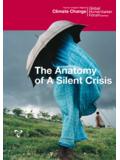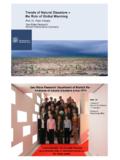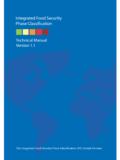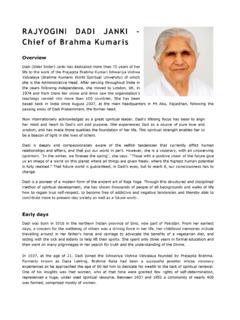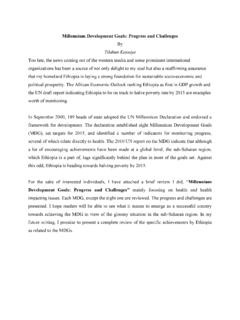Transcription of Imagining More Effective Humanitarian Aid - OECD.org
1 Imagining more Effective Humanitarian AidA Donor PerspectiveOctober 2014 Rachel Scott OECD Development Co-operation DirectorateOECD DEVELOPMENT CO-OPERATION WORKING PAPER 18 Authorised for publication by Jon Lomoy, Director, Development Co-operation Directorate Imagining more Effective Humanitarian AID: A DONOR PERSPECTIVE Imagining more Effective Humanitarian Aid: A Donor Perspective Rachel Scott1 Abstract This paper is intended to provoke debate, and stimulate further thinking and study, about Humanitarian effectiveness, and what that will mean for donors and other stakeholders, in the run-up to the World Humanitarian Summit in 2016. Today s Humanitarian system is made up of many different moving parts. These different parts are guided by different standards and learning initiatives, all aimed at promoting an Effective Humanitarian response. However, the system itself does not yet have a core set of shared values, and it is not clear whether the overall Humanitarian endeavour is fit for purpose or optimally configured, given the challenges of a changing global context, and the increasing complexity of crises.
2 A common framework for Humanitarian effectiveness, designed to promote collective responsibility and mutual accountability, would ensure that each actor would be held accountable for their contribution to the same characteristics of effectiveness based on what they can control, what they can influence and where they advocate no matter who was assessing them. No doubt, a shared understanding of Humanitarian effectiveness will also stimulate change in the design, tools and approaches, and results measurement, within the Humanitarian system. OECD Working Papers should not be reported as representing the official views of the OECD or of its member countries. The opinions expressed and arguments employed are those of the authors. OECD Working Papers describe preliminary results or research in progress by the author(s) and are published to stimulate discussion on a broad range of issues on which the OECD works.
3 Comments on the present Working Paper are welcomed and may be sent to the Development Co-operation Directorate, OECD, 2 rue Andr -Pascal, 75775 Paris Cedex 16, France. This document and any map included herein are without prejudice to the status of or sovereignty over any territory, to the delimitation of international frontiers and boundaries and to the name of any territory, city or area. 1 Rachel Scott is the Senior Humanitarian Advisor in the Development Co-operation Directorate of the OECD. The ideas expressed in this paper are those of the author and do not represent the views of the OECD, the OECD s Development Assistance Committee (DAC), or their member countries. The author would like to thank Dominique Albert, Steve Darvill, Karen Jorgensen, Katarina Kotoglou, Hetty Kovach, Peter Lundberg, Hanna Persson, Matthew Sayer, Maria Thorin, and Hong-Won Yu for excellent comments on an earlier draft of this paper.
4 The author would also like to express her gratitude to the 2013/2014 Co-chairs of the Good Humanitarian Donorship Initiative, Kaisa Heikkil and Ville Lahelma from the Finnish Ministry of Foreign Affairs, and Maria Victoria Romero Caballero from the Mexican Ministry for Foreign Affairs, for facilitating the research for this paper. Thanks also go to the many donor colleagues who provided valuable inputs as part of the research, and to Stephanie Co c who prepared the paper for publication. i Imagining more Effective Humanitarian AID: A DONOR PERSPECTIVE Executive Summary On face value, the Humanitarian system contains all the necessary assets for delivering an Effective response, but it is not yet producing consistent, optimal results. WHAT IS THIS PAPER ABOUT? The Humanitarian system is made up of many different moving parts, each with different comparative advantages, different interests and different capacities.
5 These factors determine what individual agencies, states, and people can do or control, what they can influence, and where they are more Effective as advocates. There are different assumptions about how the parts of the system fit together, and many different standards and principles to guide good practice. However, power dynamics an unspoken but very real part of Humanitarian action coupled with a complex and constantly changing operating environment, and the lack of a common definition of success, often prevent the different parts of the system from working together in an optimal manner. In addition, it is not clear whether the different actors that make up the system are ready for what will be, from all accounts, a very challenging and crisis-prone future. This paper is intended to provoke debate, and stimulate further thinking and study, about Humanitarian effectiveness, and what this will mean for donors and other stakeholders, rather than to propose a definite solution or framework.
6 Nevertheless, it has been interesting to note that the donors interviewed for this study eleven major players in the global Humanitarian system, who collectively provided USD billion of funding in 2012 are broadly aligned on what factors are important for Humanitarian effectiveness, and on what needs to be done to increase effectiveness in the face of both recurring and new global and local challenges. CAN WE IMAGINE A COMMON FRAMEWORK FOR Humanitarian EFFECTIVENESS? Operational actors, affected populations and states, donors and policymakers can t be put into neat boxes, but they can, and should, be held accountable for their contribution to Humanitarian effectiveness. Arguably, a system of collective responsibility and mutual accountability could work best. A common framework of Humanitarian effectiveness would mean that each actor would be held accountable for their contribution to the same characteristics of effectiveness based on what they can control, what they can influence, and where they advocate no matter who was assessing them.
7 This paper proposes four sets of characteristics that are critical for Humanitarian effectiveness: Humanitarian effectiveness is a shared responsibility, but with different roles programmes should be grounded in comparative advantage, they should be forward-looking, and they should respect fundamental principles. Humanitarian effectiveness begins with Effective programme design programmes should aim to maximise reach, be adapted to the context, be demand driven, focus on results, and be good value for money. Humanitarian effectiveness needs the right tools and partnerships programmes should be predictable and flexible, they should be timely, and co-ordinated, working together in partnership. Humanitarian effectiveness must be measured, demonstrated and improved through system-wide learning, and accountability. ii Imagining more Effective Humanitarian AID: A DONOR PERSPECTIVE HOW ARE DONORS Imagining A more Effective RESPONSE?
8 Business models, including the way we plan and deliver Humanitarian assistance, need to change and evolve if they are to remain fit for purpose. Donors interviewed for this paper have made a number of suggestions to ensure that the Humanitarian system is optimally configured, both to meet today s challenges, and to provide assistance more effectively in the future. These changes can be grouped under three main headings: 1. Moving away from the one-size-fits-all response model 2. Adapting and refining programming tools and concepts 3. Clarifying when, where and why the response is Effective Some of these suggestions provide quick wins for the Humanitarian system, others require a step change in the way Humanitarian programmes are designed, delivered, enabled and measured. Interestingly, however, most of the proposed options for improved effectiveness will require collective efforts and change, across the entire Humanitarian system.
9 It seems we are beyond that time when individual actions, by individual actors, will be enough to improve overall results from Humanitarian interventions. Donors are already making changes to their own systems and processes. Many of these changes have been part of wider organisational processes, often brought on by a tight fiscal environment, a push for value for money, or changes in government policy. The reviews have resulted in staffing reductions, changes to quality control processes, a shift towards more active and comprehensive risk management, and stronger links with either foreign policy or development and stabilisation colleagues, or both. Perhaps as a result, maintaining the core identity of the Humanitarian programme, and defending Humanitarian principles with colleagues across government, remains a struggle for many donors. In addition, donors have also sought to improve Humanitarian effectiveness by investing in cash based programming, improving the quality of grant funding, increasing investments in research, and focusing more strongly on results.
10 What next? The 2016 World Humanitarian Summit provides a useful opportunity to tackle the question of Humanitarian effectiveness head on, providing a forum where the broader Humanitarian system could agree on a common framework for Humanitarian effectiveness, to which all actors will be held accountable, no matter what their capacity to do , influence , or advocate . As such, the only recommendation from this study is to seize the opportunity that the Summit provides, and to work towards a common framework for Humanitarian effectiveness, and to then use this shared set of values to design better, results-driven, context-appropriate responses through Effective tools and partnerships, that will in turn enable people at risk of terrible, urgent, life-threatening suffering to make the best possible decisions about how to protect themselves and those for whom they are responsible. 1 Imagining more Effective Humanitarian AID: A DONOR PERSPECTIVE Introduction The United Nations Secretary-General will convene the first-ever global Humanitarian summit of this scale in Istanbul in 2016.










